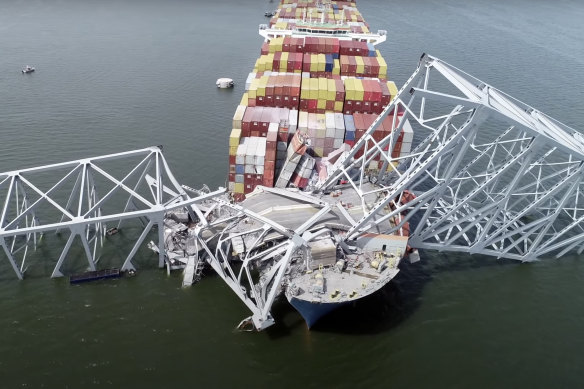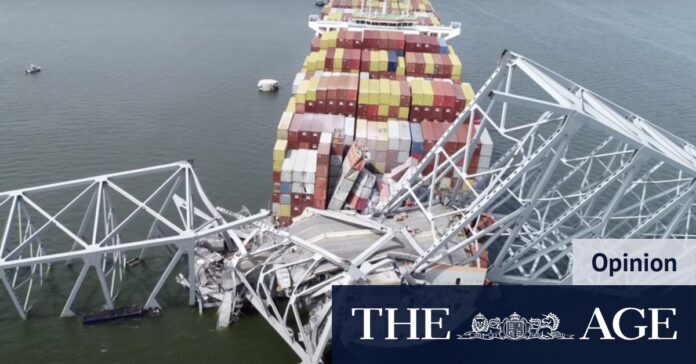[ad_1]
It has been a week since the container ship Dali struck the Francis Scott Key Bridge in Baltimore. It’s still stuck there, and the images continue to amaze, in part because the vessel is so huge compared with what’s left of the bridge. How could planners not have realised that operating superships in the harbour’s confined waters posed a risk?
And with the ship and pieces of the bridge blocking the harbour entry, the Port of Baltimore remains closed. How big a deal is that for the economy?

An image taken from video released by the National Transportation and Safety Board, the cargo ship Dali is stuck under part of the structure of the Francis Scott Key Bridge.Credit: AP
Well, it would have been quite a big deal if it had happened in late 2021 or early 2022, when global supply chains were under a lot of pressure. Remember when all those ships were steaming back and forth near Los Angeles, waiting for a berth?
It’s less important now: pre-Dali, Baltimore was only the 17th busiest US port, and there’s apparently enough spare capacity that most of the cargoes that would normally have passed through Baltimore can be diverted to other east coast ports. The Dali is no Ever Given, the ship that blocked the Suez Canal when it ran aground in 2021.
Still, global supply chains don’t have as much slack as they did, say, last summer, after pandemic disruptions were mostly a thing of the past, because Baltimore isn’t the only problem. The Panama Canal is operating at reduced capacity because a historic drought, probably in part a consequence of climate change, has limited the supply of water to fill the canal’s locks.
Loading
Elsewhere, the Houthis have been firing missiles at ships entering or leaving the Red Sea, that is, heading to, or from, the Suez Canal. Presumably as a result of these and other problems, the New York Fed’s widely cited index of global supply chain pressure, while still not flashing the red lights it was showing in the winter of 2021-22, has worsened significantly since last August.
And given what we know about the causes of the inflation surge of 2021-22, this worsening makes me a bit nervous.
I think it’s fair to say that a great majority of economists were caught flat-footed one way or another by inflation developments over the past three years. Along with many others, I failed to predict the big initial run-up in inflation. But even most economists who got that part right appear in retrospect to have been right for the wrong reasons, because they failed to anticipate the “immaculate disinflation” of 2023: inflation plunged, even though there was no recession, and the high unemployment some claimed would be necessary to get inflation down never materialised.
[ad_2]
Source link


